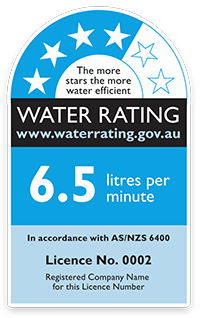Saving water
There are many ways to save water around the house, office or garden. Using well-designed plumbing systems and water-saving products can help you reduce your water use. If you are planning to install water-saving devices, make sure you engage a registered or licensed plumber to do the work.
Water Efficiency Labelling and Standards (WELS) scheme
 Appliances such as dishwashers and washing machines can often use a large amount of water. Under the Australian Government’s WELS scheme, certain products must be registered and display a label that indicates how water efficient they are. A simple system of one to six stars shows increasing water efficiency.
Appliances such as dishwashers and washing machines can often use a large amount of water. Under the Australian Government’s WELS scheme, certain products must be registered and display a label that indicates how water efficient they are. A simple system of one to six stars shows increasing water efficiency.
Products regulated in the scheme include washing machines, dishwashers, taps, showers and toilets. When purchasing these products, try to choose a product that has a high water efficiency rating.
You can check product registration and compare product performance via the WELS database on the Australian Government’s Water Rating website.
By 2030, the WELS scheme is expected to cut household utility bills by over $2 billion per year and save more than 200 billion litres of drinking water annually.
If you’re building or renovating, and your builder or plumber is supplying your household appliances or fixtures, they must make sure every product covered by the WELS scheme is registered and labelled correctly.
Tips for saving water
Besides choosing water-efficient appliances, there are many other ways to save water in the home, workplace or garden. For more ideas, visit the Victorian Government’s Using water wisely webpage.
At home or in the workplace
- Check for leaks – Leaking taps, pipes or dishwasher hoses can waste more than 2,000 litres of water per month. Replace washers regularly to avoid leaks.
- Install water efficient tapware – Combining water efficient tapware with aerators and flow restrictors can help reduce water use by 50 per cent compared with standard tapware.
- Turn off taps – Leaving taps running when not in use can waste up to 17 litres per minute. Ensure you turn off taps when brushing teeth, washing vegetables or cleaning.
- Take shorter showers – This can save hundreds of litres of water each year.
- Installing a dual flush toilet – Dual flush toilets use up to 60 per cent less water than single flush toilets.
- Recycling water – You can reuse some of your household wastewater, known as greywater, to use for watering your garden or for toilet flushing. Stormwater can also be collected and used for flushing toilets. For more information, see our greywater and stormwater pages.
In the garden
- Select drought tolerant plants – Low water-use plants and shrubs that endure drought conditions will reduce the amount of water your garden needs, and they can look good all year round.
- Mulch your garden – Using organic mulch, such as cow/chicken manure or compost, can improve the quality and water retention of your soil. Mulched garden beds retain more water and require water less often. Look out for products that can assist your soil to retain water.
- Soak your plants – Giving your plants a good soak once a week will help them develop their root systems more effectively than a light, regular spray. Healthy plants are more likely to survive tough conditions.
- Install a rainwater tank – Using water from a rainwater tank can supplement your water sources for the home and garden.
- Use recycled water – Installing a greywater system can provide a great source of water for your garden.
- Weed – Regular weeding will stop weeds from competing for water with your plants.
- Watering systems – Using a below-ground drip irrigation system can deliver water straight to the roots of your plants, where they need it most. Below ground watering systems are important if you are using recycled water because they help reduce the health risks associated with greywater.
